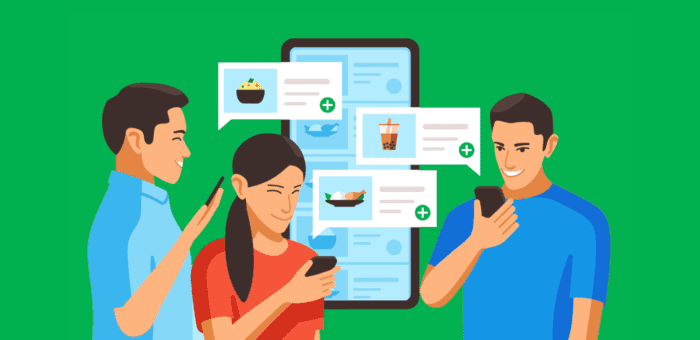Cost is a huge factor in determining when and which Grab services users choose. We know this from our user behaviour data across our eight markets in Southeast Asia.
But simply lowering prices can directly impact the income of drivers, making it unsustainable for them to remain on our platform.
The way we drive affordability is by improving efficiency and productivity, so that we can lower our cost to serve and pass on these savings to consumers.
To do this, we rely heavily on our tech to develop new service types and products for everyone on our platform.
(Read more: The key to Grab driver-partners earning more: Productivity)
Our latest innovations cover both ride-hailing and food delivery segments, as a commitment to making our services more accessible to consumers in Southeast Asia while maintaining a fair income for drivers.
Here’s a selection of projects that our markets can look forward to in the coming months.
Deliveries
Group order

Sharing a meal brings people together. So in 2020, we rolled out group order to support social gatherings. It allows for multiple people to add food items into a shared cart, and save on delivery fees when they split the bill. We have since been working on a series of enhancements to further simplify the process of coordinating a group order. They include:
- QR code invites: Users who set up a group order can now invite those around them to join the group via a QR code on their Grab app.
- Order deadlines: With multiple people adding items simultaneously, it’s hard to keep track of when all the orders are in. That’s why we’ve introduced a cut-off mark that users can set for the group order.
- Shared order tracking: All members of the group would be able to track the progress of the order via their own Grab apps.
- Smart bill calculation: We have cut down the complexities of manually having to split the bill. The new bill splitting ability will show what each person owes clearly—either by the entire order amount or by individual order.
Saver delivery
Affordability landing page

While we’re proud to offer a wide variety of options to choose from, we want to serve up what the user wants, to help them get to a suitable choice sooner. So we are building a dedicated budget-friendly page for consumers to easily discover all of GrabFood’s affordable options in one place.
To be rolled out across the region in early 2024, the page will feature options to save on delivery fees, a list of affordable merchants, or attractive campaigns and promos. Consumers will also be able to make use of browsing filters to set their preferred meal and delivery budgets.
Dine-in vouchers

We wanted to reach consumers who prefer dining out to ordering in. So this year, we rolled out a new dine-in feature in select cities across the region. Consumers can use the Grab app to discover nearby deals, read restaurant reviews, purchase dine-in vouchers, and book rides to their chosen restaurants.
Transport
Carsharing
Users who are travelling in similar directions can share a ride for lower fares. For driver-partners, dropping multiple passengers off along the way allows them to complete more trips in a day, so they can earn more. In Singapore and the Philippines, it’s called GrabShare; in Malaysia, it’s JustSave; in Indonesia, GrabCar Bareng.
In an update this year, we ensured that all shared riders will be matched with the driver before the ride commences. Previously, new bookings could be allocated into an ongoing trip that was in progress, which at times led to unexpected detours.
We’ve also shortened the overall trip time by allowing just two bookings per shared ride. In the previous version, up to three bookings could be allocated for a shared ride.
These new innovations aim to offer users more options at lower price points while improving earning opportunities for our driver- and merchant-partners. Our tech and product teams will continue to find ways to improve and create new features for everyone on the Grab marketplace.
3 Media Close,
Singapore 138498
Komsan Chiyadis
GrabFood delivery-partner, Thailand
COVID-19 has dealt an unprecedented blow to the tourism industry, affecting the livelihoods of millions of workers. One of them was Komsan, an assistant chef in a luxury hotel based in the Srinakarin area.
As the number of tourists at the hotel plunged, he decided to sign up as a GrabFood delivery-partner to earn an alternative income. Soon after, the hotel ceased operations.
Komsan has viewed this change through an optimistic lens, calling it the perfect opportunity for him to embark on a fresh journey after his previous job. Aside from GrabFood deliveries, he now also picks up GrabExpress jobs. It can get tiring, having to shuttle between different locations, but Komsan finds it exciting. And mostly, he’s glad to get his income back on track.

